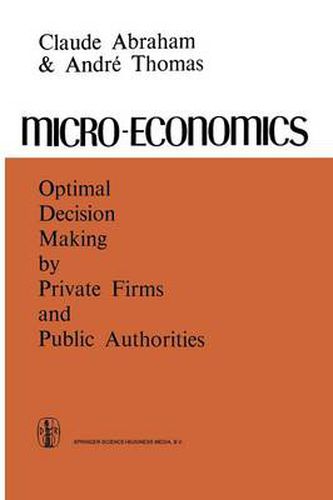Readings Newsletter
Become a Readings Member to make your shopping experience even easier.
Sign in or sign up for free!
You’re not far away from qualifying for FREE standard shipping within Australia
You’ve qualified for FREE standard shipping within Australia
The cart is loading…






This title is printed to order. This book may have been self-published. If so, we cannot guarantee the quality of the content. In the main most books will have gone through the editing process however some may not. We therefore suggest that you be aware of this before ordering this book. If in doubt check either the author or publisher’s details as we are unable to accept any returns unless they are faulty. Please contact us if you have any questions.
The origin of this work is to be found in the cyclostyled course on ‘The optimal allocation of resources in the firm and in the Nation’ taught by Mr Boiteux at the Centre d'Etudes des Programmes Economiques (C. E. P. E. ), Paris from 1957 to 1960. Of course, several successive later rewritings and a great many additions have profoundly altered the initial version: starting from a remarkably clear and concise exposition of eco nomic theory, we have ended with a book that is several hundred pages long. It is not at all certain that Mr Boiteux would recognise this intellec tual sponsorship. Nor is it certain that the gain in information justifies such an increase in size. However that may be, the initial plan has survived. Without Mr Boiteux this book would never have been undertaken: it is a pleasant duty for us respectfully to acknowledge our debt to him here. Microeconomic analysis, that is to say that analysis which results from the study of the behaviour and activities of individual decision-units, was for a long time the main concern of the neo-classicists. Quite recently the introduction of macroeconomic theory, dealing with aggregate quan tities, seemed to relegate it to second place. But this is not where it belongs: we tend to agree with Mr Raymond Barre that there are two different scales of analysis that complement rather than contrast with one another .
$9.00 standard shipping within Australia
FREE standard shipping within Australia for orders over $100.00
Express & International shipping calculated at checkout
Stock availability can be subject to change without notice. We recommend calling the shop or contacting our online team to check availability of low stock items. Please see our Shopping Online page for more details.
This title is printed to order. This book may have been self-published. If so, we cannot guarantee the quality of the content. In the main most books will have gone through the editing process however some may not. We therefore suggest that you be aware of this before ordering this book. If in doubt check either the author or publisher’s details as we are unable to accept any returns unless they are faulty. Please contact us if you have any questions.
The origin of this work is to be found in the cyclostyled course on ‘The optimal allocation of resources in the firm and in the Nation’ taught by Mr Boiteux at the Centre d'Etudes des Programmes Economiques (C. E. P. E. ), Paris from 1957 to 1960. Of course, several successive later rewritings and a great many additions have profoundly altered the initial version: starting from a remarkably clear and concise exposition of eco nomic theory, we have ended with a book that is several hundred pages long. It is not at all certain that Mr Boiteux would recognise this intellec tual sponsorship. Nor is it certain that the gain in information justifies such an increase in size. However that may be, the initial plan has survived. Without Mr Boiteux this book would never have been undertaken: it is a pleasant duty for us respectfully to acknowledge our debt to him here. Microeconomic analysis, that is to say that analysis which results from the study of the behaviour and activities of individual decision-units, was for a long time the main concern of the neo-classicists. Quite recently the introduction of macroeconomic theory, dealing with aggregate quan tities, seemed to relegate it to second place. But this is not where it belongs: we tend to agree with Mr Raymond Barre that there are two different scales of analysis that complement rather than contrast with one another .